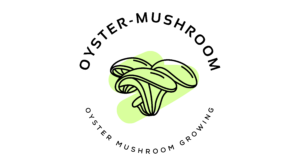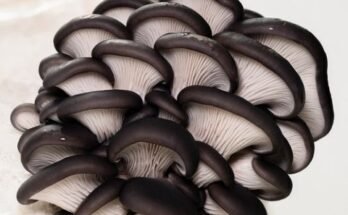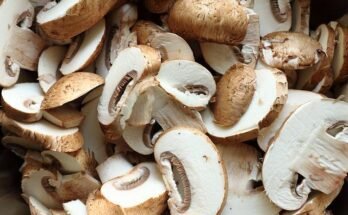Oysters are a delicious and versatile type of mushroom that can be grown at home using liquid culture. This method is a simple and effective way to grow a thriving mushroom colony. Using a liquid culture to grow oyster mushrooms could leave you feeling more like a scientist than a hobbyist. However, it is not something extremely difficult and you shouldn’t be afraid to try this technique on your own.
What Is a Liquid Culture?
Liquid culture is a sterile mixture of a few specific sugars and water. The purpose of mixing these components together is to provide mycelium with a nutritious environment. Liquid culture makes inoculating the substrate far easier.
Once the mycelium has established itself in the highly nutritious liquid, the mycelium-rich mixture can be inoculated onto a substrate that you chose to grow oyster mushrooms on, also it could be stored as a living mushroom culture as well.
Pros Of Liquid Culture
- The risk of contamination is significantly lower. With a clean oyster mushroom liquid culture, you can use a non-sterile environment for the inoculation process. This means that you can freely inoculate mushroom grains on surfaces like your kitchen counter without the risk of contamination.
- It’s a simple and beginner-friendly method. Due to the low risk of contamination, the likelihood of failure is minimal. This benefit demonstrates that liquid culture may be a great place for beginners to start.
- Less incubation time is required. Using liquid culture shortens the incubation period.
- The mycelium growth is limitless. Once it starts to develop, it does not stop. You can increase your colonization rates by utilizing more liquid culture within.
Cons Of Liquid Culture
- A sterile working environment is essential at the start. Creating your first oyster mushroom liquid culture may end up in contamination. However, there are some ways to reduce the risk like using multiple smaller jars instead of a single one.
- It’s better suited for advanced oyster mushroom cultivation. You will need basic technical and lab experience to understand how the liquid culture actually works in practice.
- You can’t see contamination inside the liquid culture. You will only know your mixture is contaminated once you start using it. To determine continuation in liquid cultures, you need a sterile environment and fundamental laboratory skills. Contamination is still difficult to detect, though.
- A stir plate is a must-have. Mixing the liquid culture by hand won’t do the job and will most likely end up in contamination.
What’s The Difference Between a Mushroom Liquid Culture and a Spore Syringe
As we already mentioned, mushroom liquid culture is a solution of nutrients and spores that is used to propagate mushrooms. It is created by adding spores to a sterilized liquid medium and allowing the spores to germinate and grow into mycelium. The mycelium is then used to inoculate a substrate.
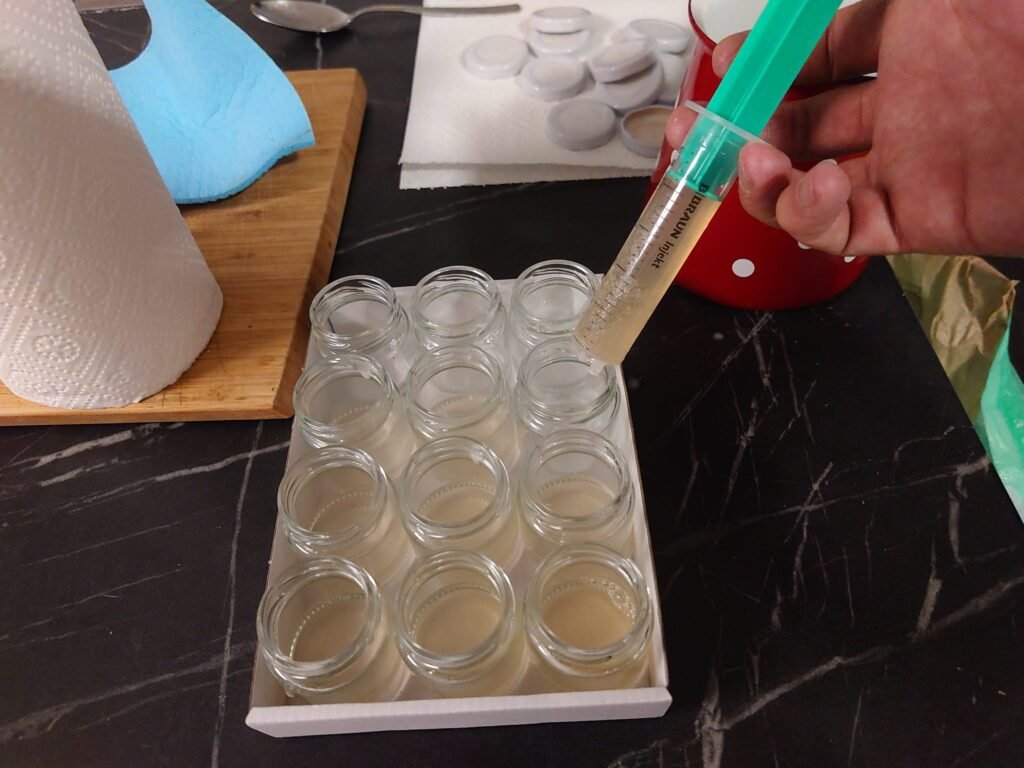
A spore syringe, on the other hand, is a syringe filled with a solution of spores suspended in water. It is used to introduce spores into a substrate or liquid culture. The spores in a spore syringe can be used to create a liquid culture or to directly inoculate a substrate, depending on the method being used.
There are several key differences between a mushroom liquid culture and a spore syringe. One of the main differences is that a liquid culture contains actively growing mycelium, while a spore syringe contains only spores. This means that a liquid culture can be used to inoculate a substrate more quickly, as the mycelium is already growing and ready to colonize the substrate. A spore syringe, on the other hand, will require more time for the spores to germinate and grow into mycelium before they can be used to inoculate a substrate.
Another difference is that a liquid culture is more prone to contamination than a spore syringe, as it contains a larger amount of living material that can be affected by outside contaminants. A spore syringe, on the other hand, is generally less susceptible to contamination, as it contains only a small amount of spores suspended in water.
How to Make Oyster Mushroom Liquid Culture
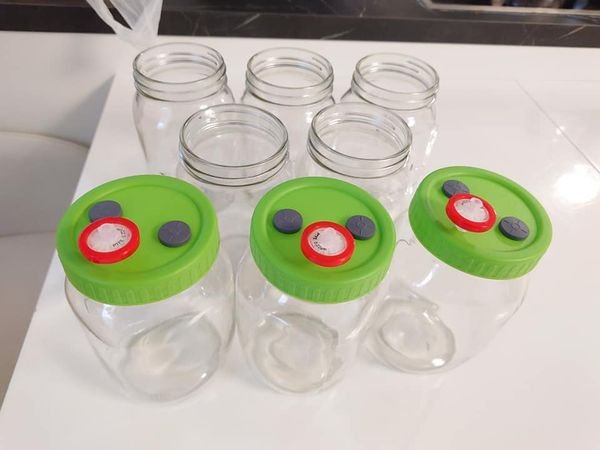
If you would like to learn how to produce Oyster mushroom liquid culture, this recipe is a good choice. Although, you can use this recipe with almost all types of mushrooms.
You will need:
- One of the following sugars: organic honey, corn syrup, corn sugar, light malt extract, or dextrose. (for the purpose of this tutorial, we will use light malt extract)
- 1L Water
- Glass marble
- 4x Mason jars.
- 4 x modified lids for mushroom growing.
- Pressure Cooker
- Aluminum foil
Household sugar (sucrose) shouldn’t be used.
The best sugar-to-water ratio
The optimal ratio is 4%. Although, 3% and 5% may also work fine, always keep in mind that too much sugar (10% or more) is going to be harmful to your mycelium.
- 1. Measure Ingredients using a precision scale, 40g of light malt extract (you may add 1 gram of brewers yeast to the mixture, however, this step is optional)
- 2. Fill each mason jar with liquid culture broth, until it reaches approximately half a jar. Add a piece of glass marble. This will help in breaking up clumps of mycelium later in the process. Place a modified lid on each jar and cover it with a piece of aluminum foil.
- 3. Sterilize the liquid culture broth using a pressure cooker, for 20 minutes at 15PSI. Before you open the pressure cooker, allow it to cool completely.
- 4. Inoculate the jars. Cooled sterile nutritious broth can now be inoculated with a live mycelium culture. When using liquid culture for inoculation, the aseptic procedure must be taken into account. Through the injection port, a liquid culture syringe should be flame sterilized and injected. For mycelium grown on agar, a laminar flow hood or a glove box is required, as opening the lid of a jar in a nonsterile environment may lead to contamination.
- 5. Gently swirl the liquid culture jar daily so that oxygenation inside the liquid increases. Be careful, you don’t want to splash liquid near the lid, where unwanted pathogens may penetrate. For best results use a magnetic stirrer. If you don’t have one this technique will work quite well.
- 6. Be patient. Mycelium needs 14 to 21 days in order to develop firmly in the liquid culture. At this point, you can use the liquid culture to inoculate more liquid cultures, grain spawns, and agar plates.
For best results, test a small batch of your liquid culture on an agar plate to verify that there are no hidden contaminants in the liquid solution.
How To Grow Oyster Mushrooms From Liquid Culture
Growing oyster mushrooms from liquid culture is a relatively simple process that can be done at home with the right materials and equipment. Here is a how-to-do-it in a few easy steps:
1. Obtain a liquid culture: You can purchase a liquid culture of oyster mushrooms or make it by yourself, as now you know how to do this crucial step.
2. Sterilize your materials: It is important to sterilize all materials that will come into contact with the mushroom culture to prevent contamination. This can be done using a pressure cooker or autoclave.
3. Prepare the substrate: Oyster mushrooms can be grown on a variety of substrates, such as straw, sawdust, coffee grounds, or cardboard. The substrate should be sterilized and then moistened to the point of being damp, but not dripping wet.
4. Inoculate the substrate: Using a sterile needle or pipette, transfer a small amount of liquid culture onto the prepared substrate. Spread the culture over the surface of the substrate, being careful to avoid contamination.
5. Incubate the substrate: Place the inoculated substrate in a warm, dark location to allow the mycelium to grow. The length of incubation will depend on the type of mushroom and the conditions, but it generally takes several weeks for the mycelium to fully colonize the substrate.
6. Initiate fruiting: Once the mycelium has fully colonized the substrate, you can initiate fruiting by increasing the humidity and providing proper ventilation and light. This can be done by misting the substrate with water and placing it in a location with indirect sunlight.
7. Harvest the mushrooms: Within a few days to a week, you should begin to see the first mushrooms forming. As the mushrooms grow, you can harvest them by gently twisting them off of the substrate.
By following these steps, you should be able to successfully grow oyster mushrooms from liquid culture. It is important to maintain proper conditions and keep the substrate and mushrooms free from contamination throughout the process.
Conclusion
Growing oyster mushrooms from a liquid culture is a useful tool for growing oyster mushrooms at home or on a larger scale. It will allow for the quick and efficient growth of mycelium, which can then be used to inoculate a substrate and produce mushrooms. By following all the steps listed above, you should now be able to successfully make your own liquid culture and grow nice and beautiful oyster mushrooms!
